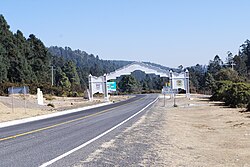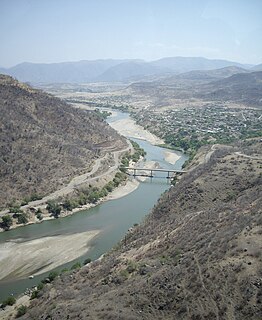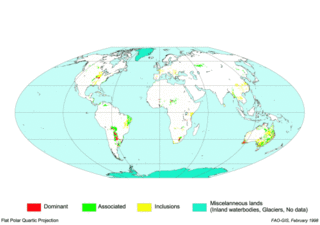
Campeche is a state in Southeast Mexico that is divided into eleven municipalities. According to the 2015 Mexican Intercensal Survey, Campeche is the third least populous state with 899,931 inhabitants and the 17th largest by land area spanning 57,693.59 square kilometres (22,275.62 sq mi).

Chiapas is a state in Southwest Mexico. According to the 2015 Mexican Intercensal Survey, it is the state that has the seventh largest population with 5,217,908 inhabitants and the 10th largest by land area spanning 73,560.47 square kilometres (28,401.86 sq mi). Chiapas is officially divided into 124 municipalities, although the establishment of municipal authorities in Belisario Domínguez has been suspended since 2015 pending the resolution of a territorial dispute between Chiapas and the neighbouring state of Oaxaca. A 125th municipality called Honduras de la Sierra, consisting of six ejidos currently part of Siltepec, will be incorporated on October 1, 2018.

Colima is a state in West Mexico that is divided into ten municipalities. According to the 2015 Mexican Intercensal Survey, it is the state that has the smallest population with 711,235 inhabitants and is the fifth smallest by land area spanning 5,801.75 square kilometres (2,240.07 sq mi).

The Mazahuas are an indigenous people of Mexico, primarily inhabiting the northwestern portion of the State of Mexico and small parts of Michoacán and Querétaro. The largest concentration of Mazahua is found in the municipalities of San Felipe del Progreso and San José del Rincón of the State of Mexico. There is also a significant presence in the Federal District, Toluca and the Guadalajara area owing to recent migration. According to the 2010 Mexican census, there are 116,240 speakers of the language in the State of Mexico, accounting for 53% of all indigenous language speakers in the state.

La Huacana Municipality is a municipality in the south-central part of the Mexican state of Michoacán. It has a population of 32,757. Its municipal seat is the city of the same name.
Villa Donato Guerra is the municipal seat of the municipality called Donato Guerra in the State of Mexico, Mexico. The area is also known as Malacatepec and La Asunción Malacatepec. (Villa) Donato Guerra is located in the western part of the State of Mexico. In the region that is identified with Valle de Bravo. The town was named in 1880 in honor of Donato Guerra, a distinguished soldier of the War of La Reforma. It is located around 77 kilometers from Toluca which is the capital of the state, on Federal Highway number 35 Mexico City - Zitácuaro.
Ixtlahuaca de Rayón is a city and municipality north of Toluca in the northwest part of the State of Mexico, in Mexico. The distance between Mexico City and Ixtlahuaca is 32 km. The name Ixthahuaca comes from Náhuatl and means plains without trees. The city and municipality were officially established by decree on November 14, 1816 by the Congress of the State of Mexico.

Jilotepec de Molina Enríquez and Jilotepec de Abasolo are a town and a municipality located northwest zone of the State of Mexico, in Mexico. However, both entities are interchangeably referred to as "Jilotepec". This name comes from Náhuatl, meaning "hill of corncobs". It is located in hilly and forested terrain an hour from Mexico City, Toluca, 40 minutes from San Juan del Río, 30 minutes from Tula and 20 from Tepeji. The Mexico City–Querétaro and the new Transoceanic Freeways converge within its territory that unite the coasts of Mexico from Veracruz to Michoacán.

Progreso Municipality is one of the 106 municipalities in the Mexican state of Yucatán containing (270.10 km2) of land and located roughly 25 km north of the city of Mérida.
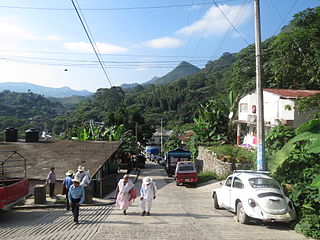
Huehuetla is a rural municipality in Puebla, Mexico.

Tlaxco is a municipality in Tlaxcala, Mexico.
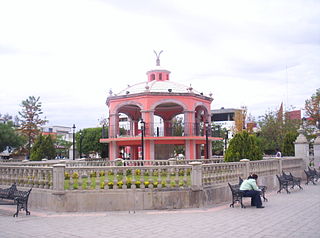
Río Grande is a municipality in the Mexican state of Zacatecas.

Zinapécuaro is a municipality in the Mexican state of Michoacán, located 50 kilometres (31 mi) northeast of the state capital Morelia.

Tomatlán is a municipality in the Mexican state of Veracruz, located 58 kilometres (36 mi) south of the state capital of Xalapa.
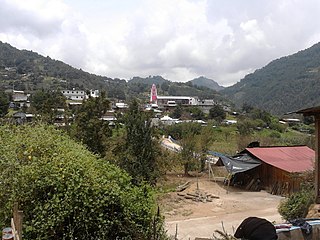
Xoxocotla is a municipality in the Mexican state of Veracruz, located 103 kilometres (64 mi) south of the state capital Xalapa.

Carácuaro is a municipality in the Mexican state of Michoacán, located 77 kilometres (48 mi) south of the state capital of Morelia.

Churintzio is a municipality in the Mexican state of Michoacán, located 104 kilometres (65 mi) northwest of the state capital of Morelia.

Cojumatlán de Régules is a municipality in the Mexican state of Michoacán, located 180 kilometres (110 mi) west of the state capital of Morelia.

Contepec is a municipality in the Mexican state of Michoacán, located 110 kilometres (68 mi) east of the state capital of Morelia.
